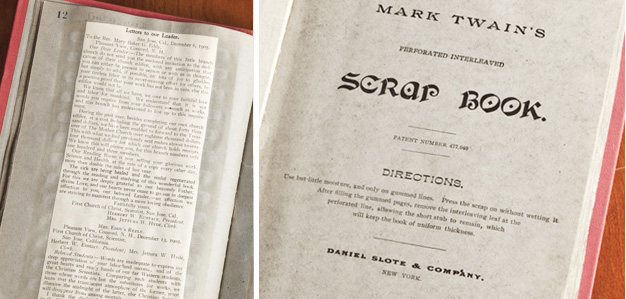Like many men and women of their day, Mary Baker Eddy and Calvin A. Frye kept scrapbooks. Eddy started keeping a personal one in about 1840, when she was nineteen years old. Later she continued collecting items with the help of Frye and others; scrapbooks were kept through 1910. They covered various topics and items of interest, including poetry, essays, news reports, observations, and items on or about Christian Science (just to name a few). Published interviews with Eddy, as well as essays, letters, and poetry by her, were also preserved.
Irving C. Tomlinson, one of Eddy’s secretaries, wrote:
Of priceless value to the Discoverer and Founder of C.S. is the old Scrap book which was carefully kept and has been carefully preserved. Speaking of it to me she said, “If the house were on fire and I had time to save but one of my treasures, I think I should save the dear old book….”1
The Library has 32 scrapbooks that belonged to Eddy and Frye in the collections. These are popular among our visitors and staff alike, for they illustrate the diversity of subjects that were of interest to Eddy.
Scrapbooks started to develop as early as Greek and Roman times: “In medieval times emblem books were produced which were bound pages of drawings with accompanying interpretations of allegorical meaning.”2 In the sixteenth century “commonplace books” became popular; they were used like modern day yearbooks, and friends would sign them or make drawings in them for the owner of the book. These books were often created as souvenirs of trips or tours. ” In the nineteenth century scrapbooking really took off, especially among middle=class Americans. In the early part of the century the friendship album was popular, as “people kept autographs, poetry, prose and wishes of their dear friends. These books were considered a feminine form of keeping memories.”3 In 1857 the “carte-de-viste” photograph came to America. Albums with pockets for photograph insertions were popular. Some of the albums had “pages for doing watercolor paintings and pencil drawings.”4 In 1872 the author Mark Twain invented the adhesive scrapbook that had pre-pasted pages. Once the pages were wet, clippings and scraps could be attached. This was one of his most popular inventions. The popularity of scrapbooks went on the decline after World War I. Later on the production of photo albums caused a further decline in popularity. In 1980 modern scrapbooking saw a resurgence when Marielen Christensen shared 50 volumes of her family memory books at the World Conference on Records in Utah. Today scrapbooking is a fast growing hobby.
The Eddy/Frye scrapbooks were created not to just preserve personal memories. Before there were archivists, microfilm, and the Internet, these were ways of preserving clippings for reference and possible future use, and keeping track of news and events.
- Irving Tomlinson, n.d., A12026
- “A Scrapbook Timeline,” Tulane University, accessed September 11, 2015, https://tulane.edu/newcomb/scrapbook-timeline.cfm.
- Ibid.
- “History of Scrapbooking,” Everything About Scrapbooking, accessed September 11, 2015, http://www.everything-about-scrapbooking.com/history-of-scrapbooking.html.




